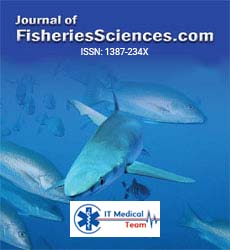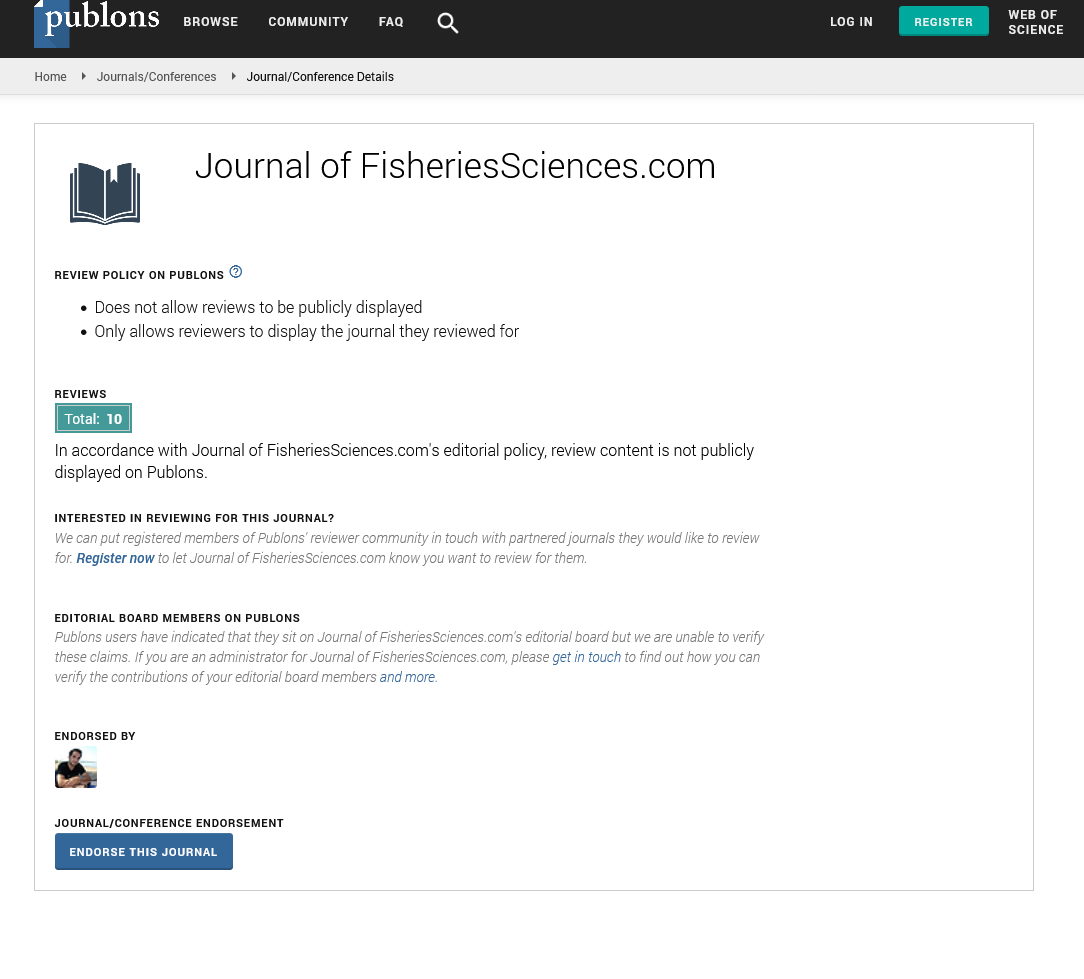Perspective - (2024) Volume 18, Issue 5
Unraveling the Dance of Life: Understanding Fish Population Dynamics
Rahul Renapurkar*
Department of Environmental Conservation, University of Massachusetts Amherst, Amherst, USA
*Correspondence:
Rahul Renapurkar, Department of Environmental Conservation, University of Massachusetts Amherst, Amherst,
USA,
Email:
Received: 18-Jan-2024, Manuscript No. IPFS-24-14512;
Editor assigned: 23-Jan-2024, Pre QC No. IPFS-24-14512 (PQ);
Reviewed: 06-Feb-2024, QC No. IPFS-24-14512;
Revised: 01-Oct-2024, Manuscript No. IPFS-24-14512 (R);
Published:
29-Oct-2024
Introduction
Fish population dynamics, the study of the complex
interactions governing the abundance and distribution of fish in
aquatic ecosystems, is a crucial field in fisheries science. As our
reliance on fish for sustenance and economic well-being grows,
understanding the factors that influence fish populations
becomes imperative for sustainable resource management. In
this article, we will explore the intricacies of fish population
dynamics, examining the key processes, environmental factors
and human influences that shape the ebb and flow of fish
numbers in our oceans, rivers and lakes.
Description
Processes influencing fish population dynamics
Reproduction and recruitment: The foundation of fish
population dynamics lies in the reproductive processes that
sustain the continuity of species. Fish exhibit various
reproductive strategies, from prolific egg-layers to species with
complex parental care systems. Recruitment, the successful
transition of young fish into the population, is a critical factor
influenced by spawning success, survival of eggs and larvae and
the availability of suitable habitats for juvenile fish.
Growth and mortality: Fish experience growth throughout
their lives, influenced by factors such as food availability,
temperature and genetic predispositions. Growth rates vary
among species and can be indicative of the health of a
population. Mortality, both natural and induced by predation or
fishing, is a key determinant of population size. Understanding
the balance between growth and mortality is essential for
predicting population trends.
Migration and movement: Many fish species exhibit
migratory behaviors, moving between different habitats for
feeding, spawning or avoiding environmental stressors. The
timing and patterns of fish migration can have profound effects
on population dynamics, impacting the distribution of individuals
and their interactions with other species.
Environmental factors shaping fish populations
Temperature and climate: Temperature influences various
aspects of fish biology, including metabolic rates, growth and reproduction. Changes in climate patterns can alter water
temperatures, affecting the distribution and behavior of fish
species. Understanding these climate-induced shifts is crucial for
predicting how fish populations may respond to long-term
environmental changes.
Habitat quality and availability: The availability and quality of
suitable habitats are critical for fish populations. Degradation of
habitats, whether through pollution, habitat destruction or
alteration of water flow, can have detrimental effects on fish
populations. Conservation efforts often focus on preserving and
restoring critical habitats to support healthy fish communities.
Food availability: The abundance and distribution of prey
species directly influence the condition and growth of fish
populations. Changes in the availability of food resources, driven
by factors such as overfishing or alterations in the food web
structure, can cascade through the ecosystem, impacting
predator-prey relationships and overall fish population health.
Oceanographic conditions: Oceanographic factors, such as
currents, upwelling and salinity, play a vital role in shaping the
distribution of marine fish populations. These conditions affect
the transport of nutrients, larval dispersion and the availability of
prey, contributing to the dynamic nature of fish populations in
marine environments.
Human influences on fish population dynamics
Overfishing: Overfishing, the excessive removal of fish from a
population, is a major threat to fishery sustainability. Harvesting
beyond the reproductive capacity of a population can lead to
declines in abundance and disrupt the natural balance of
ecosystems. Sustainable fisheries management is essential to
prevent overfishing and promote the long-term health of fish
populations.
Habitat destruction: Human activities, such as dredging,
coastal development and pollution, can lead to the destruction
of crucial fish habitats. Loss of spawning grounds, nursery areas
and feeding habitats directly impacts fish population dynamics.
Conservation efforts focus on mitigating habitat destruction to
preserve the ecological functions these areas provide.
Introduction of invasive species: The introduction of nonnative
species can have detrimental effects on native fish
populations. Invasive species may outcompete native species for
resources, introduce diseases or disrupt established predator- prey relationships. The presence of invasive species can lead to
significant changes in fish population dynamics and ecosystem
structure.
Climate change: Climate change poses multifaceted
challenges to fish populations. Rising temperatures, ocean
acidification and altered precipitation patterns can impact fish
habitats, food availability and migration routes. Adapting to
these changes requires a comprehensive understanding of how
climate-related stressors affect different aspects of fish
population dynamics.
Conservation and sustainable management
Preserving fish populations and ensuring sustainable fisheries
require a holistic and science-based approach. Conservation
efforts often involve the establishment of marine protected
areas, habitat restoration projects and the implementation of
responsible fishing practices. Sustainable fishery management
strategies aim to balance human needs with the capacity of fish
populations to reproduce and replenish.
Technological advances in studying fish population
dynamics
Advancements in technology have greatly enhanced our ability
to study fish population dynamics. Acoustic telemetry allows scientists to track the movements of individual fish, providing
insights into migration patterns and habitat use. Environmental
DNA (eDNA) analysis enables the detection of fish species
through the genetic material they shed into the environment,
offering a non-invasive method for monitoring populations.
Conclusion
Fish population dynamics represent a complex interplay of
biological, environmental and anthropogenic factors. As we
navigate the challenges of sustaining fisheries for future
generations, a deep understanding of these dynamics is
essential. The integration of scientific research, conservation
efforts and responsible management practices is crucial for
ensuring the resilience and health of fish populations in the face
of a changing world. By unraveling the intricacies of the dance of
life beneath the surface, we can strive to strike a harmonious
balance that benefits both ecosystems and human societies.
Citation: Renapurkar R (2024) Unraveling the Dance of Life: Understanding Fish Population Dynamics. J Fish Sci. Vol.18 No.5






